Share the post "Traditional Texan Wildflowers: Be Part of The Colorful Urban Garden Revolution!"
Texan wildflowers bring the prairie to our gardens and cities with vibrant colors and textures. Normally associated with vast fields and country roadsides, these hardy species are now found in towns and backyards. We love these natives’ rugged beauty because of their resilience and low maintenance. They thrive without much care because they adapt to the local climate, making them ideal for gardeners who want to capture Texas’ natural beauty.
Wildflowers create a beautiful view, connects us to the local ecosystem, and attracts a variety of wildlife, from bees to birds. With careful selection and design, wildflowers can enhance any landscaping project.
- The Allure of Texan Wildflowers in Modern Landscaping
- Choosing the Right Wildflowers for Your Region
- Types of Texas Wildflowers
- Design Principles for Wildflower Landscaping
- Integrating Wildflowers into Urban Spaces
- Benefits of Using Texan Wildflowers
- Practical Tips and Maintenance
- Overcoming Challenges in Wildflower Landscaping
- Case Studies of Successful Texan Wildflower Landscapes
Key Takeaways
- Texan wildflowers beautify and serve many landscapes.
- Wildflowers blend into urban and suburban areas with careful selection and design.
- Wildflowers compliment eco-friendly landscaping and local ecosystems.
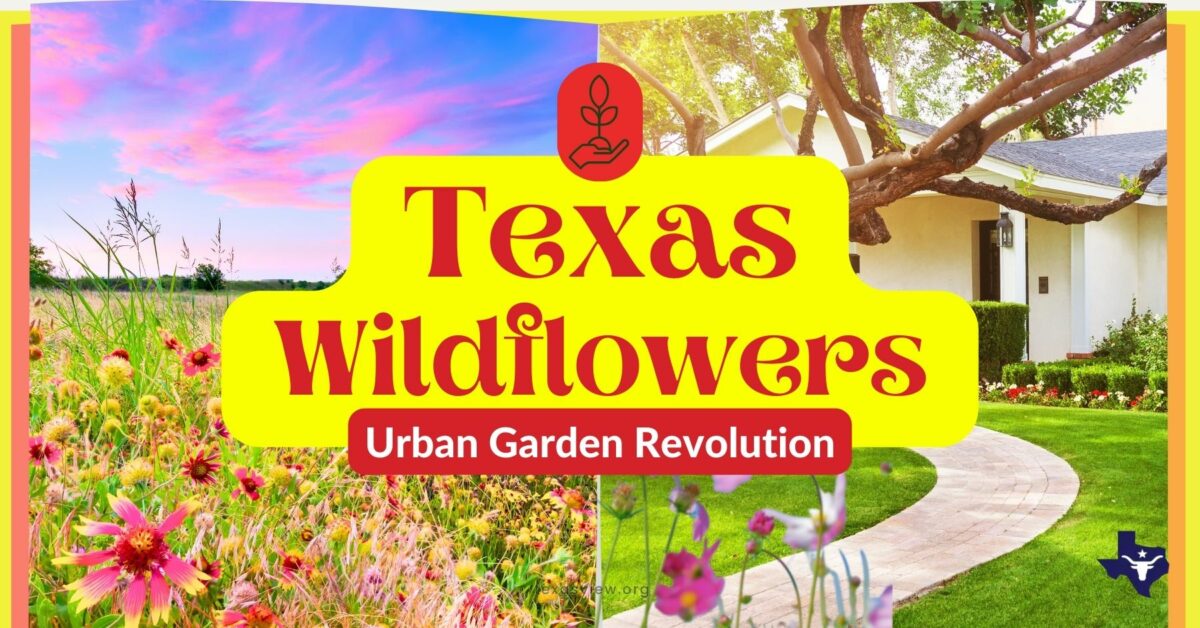
The Allure of Texan Wildflowers in Modern Landscaping
Texan wildflowers offer a vibrant palette of colors and textures that can transform mundane spaces into breathtaking landscapes. They entice us with their natural beauty and effortless charm of these native blooms.
By incorporating wildflowers like an Indian blanket, known for its red and yellow petals, we can create stunning visual tapestries throughout our gardens and public spaces, adding a warm, inviting aesthetic.
Imagine scatterings of bluebonnets, the state flower of Texas, creating a sea of tranquil blue along a stone pathway. Or, envision clusters of Mexican hats and brown-eyed Susans dotting the edges of green space, inviting local wildlife and promoting biodiversity.
The benefits of using native wildflowers include:
- Low Maintenance: They’re accustomed to the Texan climate, reducing the need for watering and care.
- Eco-friendly: Wildflowers support local ecosystems, providing habitat for bees, butterflies, and birds.
- Drought Resistance: Built to survive in Texas’s diverse regions, from the Hill Country to the Gulf Coast.
Our landscapes become a feast for the eyes and a haven for nature. By embracing Texas’s wildflower heritage, we contribute to sustainable landscaping practices and continuing the Texas tradition.. We’re not just planting flowers but nurturing a piece of Texas’s soul.
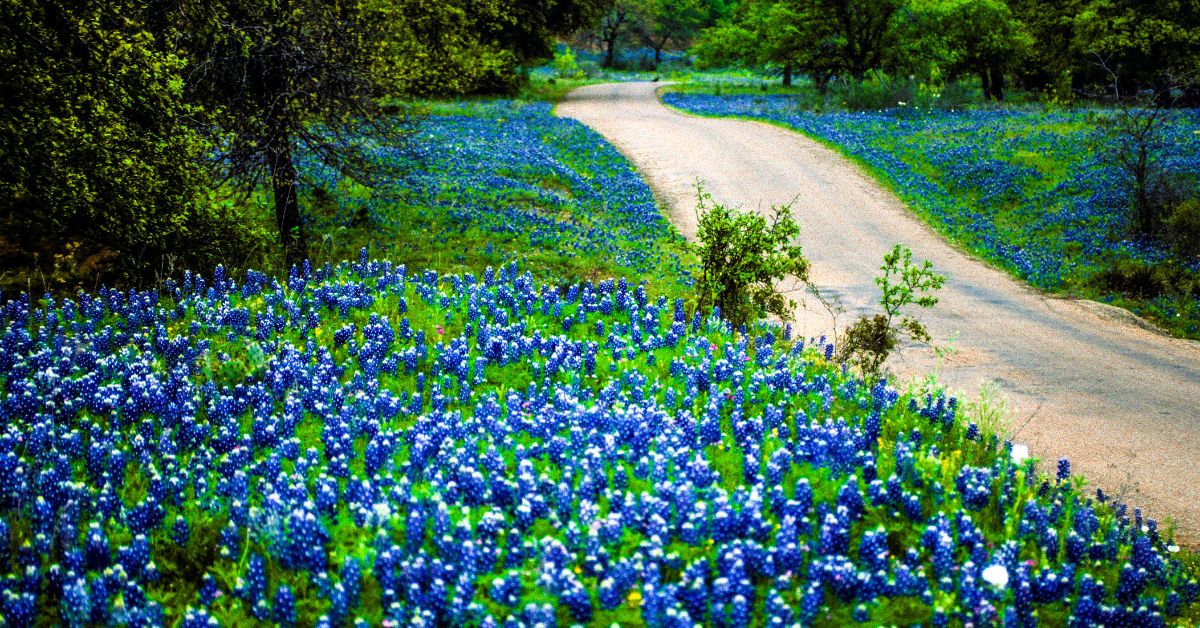
Choosing the Right Wildflowers for Your Region
Texas flowers thrive in the state’s unique climate zones, meet the soil’s specific needs, and bask in just the right amount of sunlight and water. Let’s dive into the natural beauty and resilience of Texan wildflowers.
Texan Climate Zones
Texas climate varies significantly from the humidity of the east to the arid west. North Texas experiences cold winters, while South Texas remains warm. Central Texas sees a mix of both, influencing which wildflowers will flourish in each area. For example, bluebonnets (Lupinus texensis) can withstand the fluctuating climate of Central Texas, making them iconic in Texan landscapes.
Soil Considerations for Texan Wildflowers
These wildflowers need suitable soil to flourish. Blackland Prairie soils support vibrant wildflowers like Indian Blanket (Gaillardia pulchella), while sandy soils along the coast are perfect for Seaside Goldenrod (Solidago sempervirens). To achieve a spectacular display, determine your soil type and choose species adapted to those conditions.
Wildflower Sunlight and Water Requirements
Lastly, consider the sunlight and water needs. Most wildflowers, such as the fiery Indian Paintbrush (Castilleja indivisa), crave full sun and moderate water. Yet some tolerate drought well, like the winecup (Callirhoe involucrata). Always match your wildflowers to the sunlight pattern of your garden for a thriving landscape.
Types of Texas Wildflowers
| Wildflower | Latin Name | Growing Conditions | Ideal Planting Season | Planting Zones | Additional Information |
|---|---|---|---|---|---|
| Bluebonnet | Lupinus texensis | Full sun; well-drained soil | Fall | 4-8 | Texas state flower; blooms in spring; can reseed itself for following years |
| Indian Blanket | Gaillardia pulchella | Full sun; various soil types | Fall | 4-9 | Bright red-orange blooms; drought-tolerant; attracts pollinators like butterflies and bees |
| Texas Paintbrush | Castilleja indivisa | Full sun to partial shade; well-drained soil | Fall | 4-10 | Vibrant red, tubular blooms; prefers sandy or rocky soil; attracts hummingbirds |
| Black-eyed Susan | Rudbeckia hirta | Full sun to partial shade; well-drained soil | Fall | 4-9 | Yellow daisy-like flowers with dark centers; drought-tolerant; attracts butterflies and birds |
| Purple Coneflower | Echinacea purpurea | Full sun to partial shade; well-drained soil | Fall | 3-9 | Purple daisy-like blooms with raised centers; drought-tolerant; attracts bees and butterflies |
| Winecup | Callirhoe involucrata | Full sun; well-drained soil | Fall | 6-9 | Deep pink to purple cup-shaped flowers; thrives in rocky or gravelly soil; can tolerate heat and drought |
| Texas Lantana | Lantana urticoides | Full sun; well-drained soil | Spring | 7-10 | Clusters of red, orange, and yellow flowers; attracts butterflies; toxic if ingested by humans or animals |
| Texas Bluebell | Eustoma grandiflorum | Partial shade; moist, well-drained soil | Fall | 7-10 | Bell-shaped blue-purple flowers; prefers woodland areas with some shade; may go dormant in hot, dry conditions |
| Drummond Phlox | Phlox drummondii | Full sun to partial shade; well-drained soil | Fall | 6-9 | Pink, purple, or white blooms; low maintenance; attracts butterflies and hummingbirds |
| Texas Star Hibiscus | Hibiscus coccineus | Full sun to partial shade; moist, well-drained soil | Spring | 7-10 | Large, showy red flowers with prominent stamens; thrives in wetland or boggy areas; attracts hummingbirds |
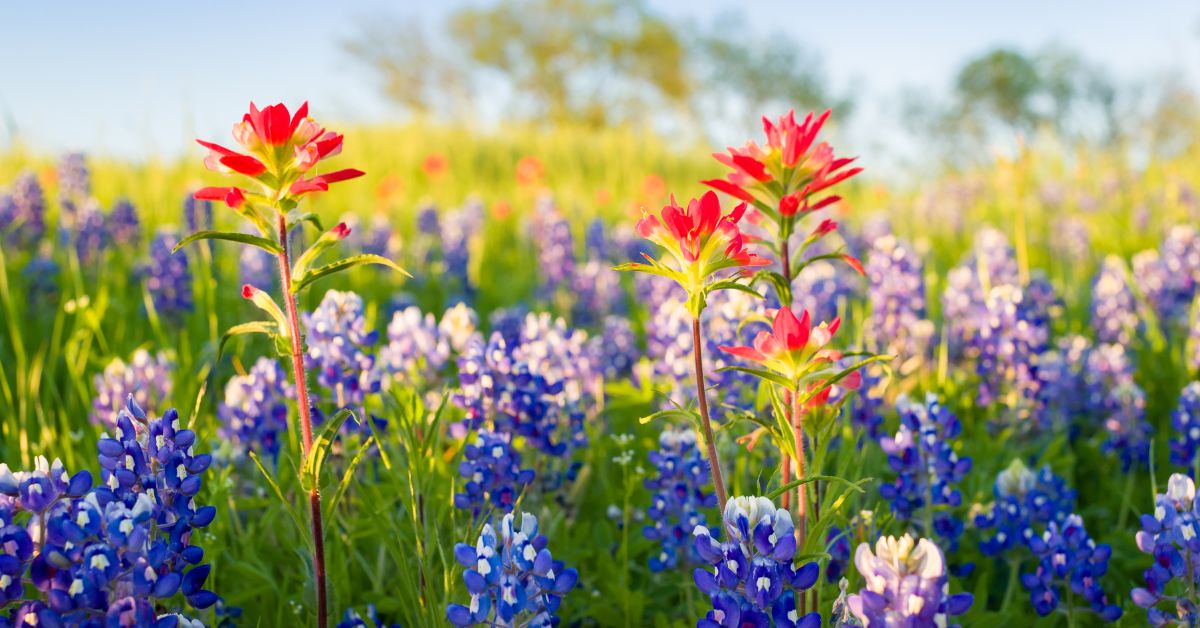
Design Principles for Wildflower Landscaping
Transform your landscapes with the vibrant beauty of Texan wildflowers, focus on design principles that celebrate local flora while ensuring a stunning display throughout the year.
Creating Texture and Color Contrasts
Texan wildflowers offer a kaleidoscope of colors and textures that can dazzle the eyes. To create a vivid contrast, we recommend considering the bold blues of the Bluebonnets against the bright yellows of the Texas Star. Alternating between Winecups’ delicate petals and Gulf Muhly grass’s feathery foliage adds a dynamic textural interplay that enchants the senses.
Incorporating Native Grasses and Plants
Native grasses and plants are the perfect companions to wildflowers, offering aesthetic and ecological benefits. By adding grasses like Little Bluestem, we increase the diversity of our garden while laying a foundation that complements seasonal blooms. Our wildflower landscapes become habitat-rich environments that invite local wildlife and promote biodiversity.
Seasonal Planning for Year-Round Appeal
Our landscapes must peak in the spring and enthrall us throughout the year. We integrate flowers like the Four Nerve Daisy, known for its long blooming period, ensuring our gardens maintain continuous color. By staggering plants with different blooming times, such as the autumn-showcasing Plateau Goldeneye, our landscapes deliver year-round interest and sustenance for pollinators.
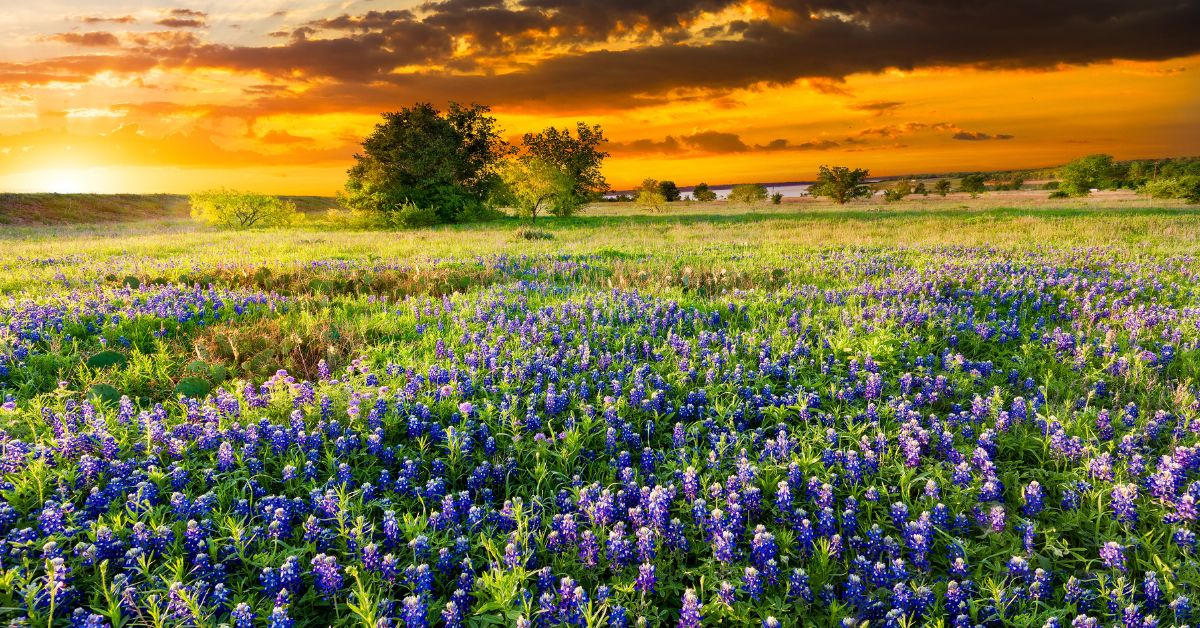
Integrating Wildflowers into Urban Spaces
Start a colorful revolution in an untapped potential of Texan wildflowers can bloom in even the most unexpected urban areas. Include these native beauties in small personal spaces and public places.
Wildflowers in Small Yards and Balconies
In small yards, strategic planting of Texas bluebonnets and Indian paintbrushes can create a stunning display with very little maintenance. We can use:
- Raised beds for clear segregation and aesthetic appeal
- Potted plants for balconies, with wildflowers that thrive in containers
It’s all about maximizing the little space we have with Texan vibrancy!
Community projects and public spaces
Communal efforts blossom when we introduce Texan wildflowers into public spaces. These robust plants provide beautiful scenery, foster local ecosystems, and conserve water. Consider the impact of:
- Seeding wildflower meadows in park areas brings life to our public gatherings.
- Installing green roofs with wildflowers, to transform urban landscapes and save energy
We’re not just planting flowers but sowing seeds for a more vibrant community.
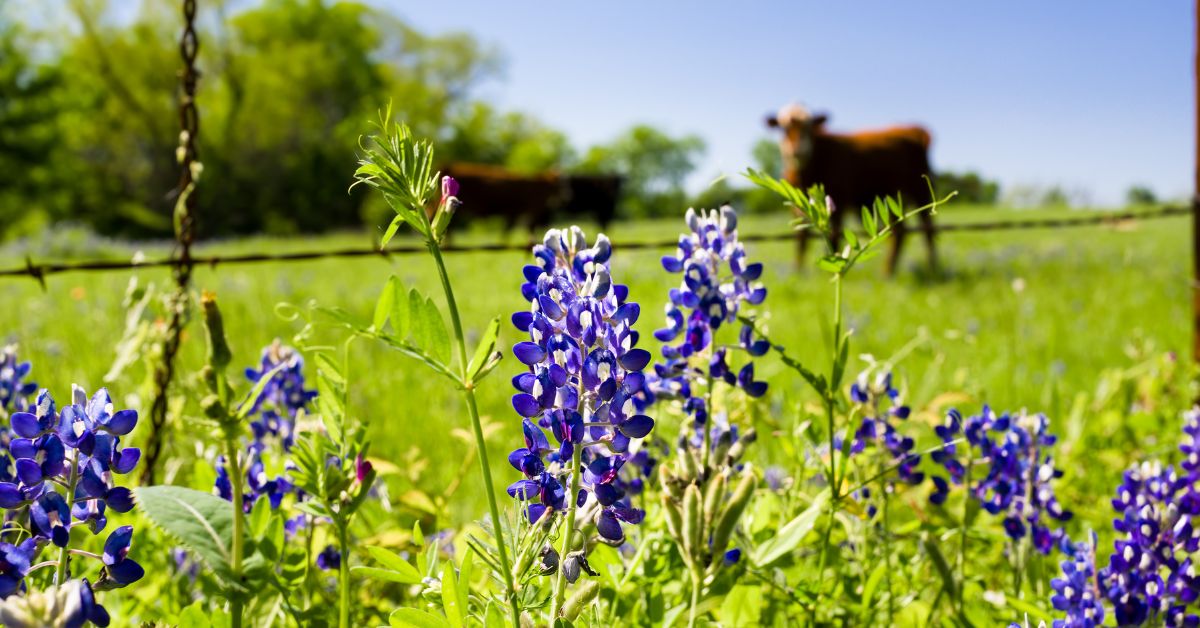
Benefits of Using Texan Wildflowers
Texan wildflowers add splashes of color and foster a thriving ecosystem in our backyards. The advantages of sustaining local wildlife and conserving water are as diverse as the flowers.
Ecosystem Services and Biodiversity
Texan wildflowers create a habitat rich in biodiversity. By integrating native species, we support pollinators like bees and butterflies, which are essential for healthy crops. It’s a win-win: our gardens look fantastic, and we help maintain a balanced ecosystem.
Water conservation and sustainability
Texas wildflowers are champions of water conservation. These hardy natives are adapted to Texas’s climate and require much less water than traditional lawns. This saves us time and money by aligning our landscaping practices with the natural rhythms of the Texas environment.
Educational Opportunities and Community Engagement
Incorporating wildflowers into our landscapes provides educational opportunities. We can engage with our community through workshops and garden tours, spreading knowledge about ecological practices. Wildflowers offer a tangible way to connect with Texas’s natural heritage, fostering a sense of pride and community.
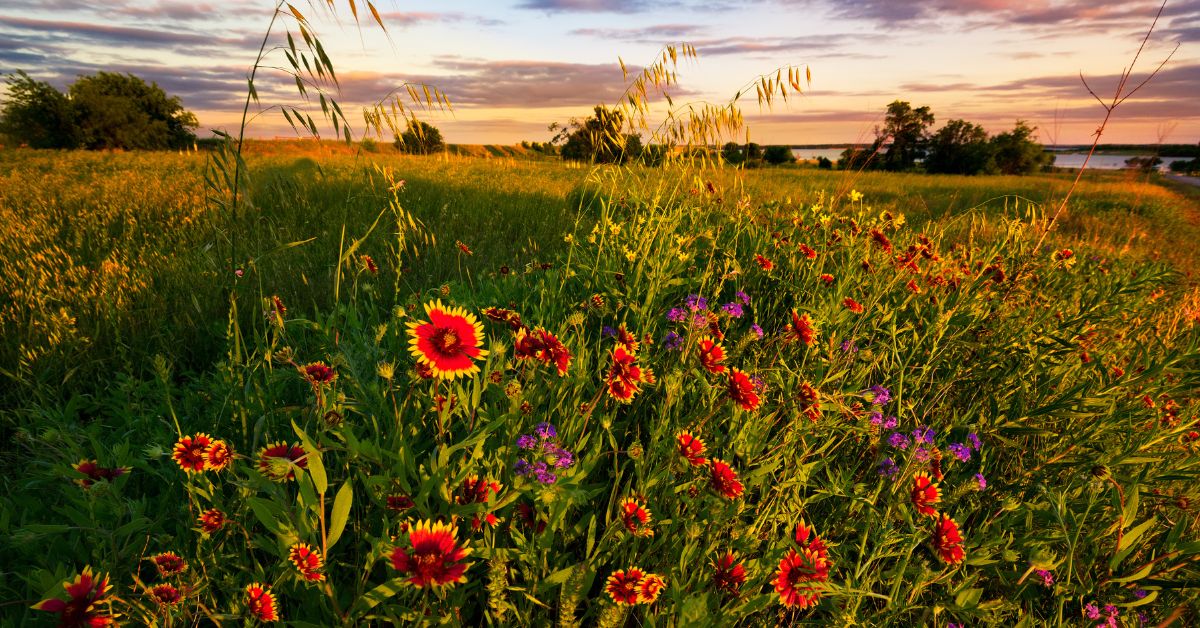
Practical Tips and Maintenance
Are you excited to add a touch of Texas to your landscape with wildflowers? We’ve covered you with essential tips and methods to help these natural beauties thrive in your garden. From sowing seeds to protecting your wildflowers from pests and handling seasonal changes, let’s ensure our blooms have everything they need to show their full potential.
Getting Started with Seeding
- Selecting Your Site: To ensure robust growth, we’ll choose a flat, sunny spot that maximizes sun exposure. Proper site preparation involves cutting grass short and raking to expose soil for the seeds.
- Seeding: Timing is critical, so we’ll seed in the fall for the best germination when spring arrives. This is the best time to plant wildflowers in Texas. We’ll scatter the seeds evenly and gently rake them into the soil.
Managing Pests and Diseases
- Natural Pest Control: Watch for signs of pests and tackle them without resorting to harsh chemicals. Introducing beneficial insects, like ladybugs, is a natural way to control aphids and other common pests.
- Disease Prevention: We can prevent many fungal diseases by spacing our wildflowers properly and ensuring good air circulation. If we see signs of disease, we’ll promptly remove and dispose of the affected plants to protect the rest.
Seasonal Maintenance and Care
- Post-Bloom Care: Once our wildflowers have finished blooming, we’ll allow them to go to seed to propagate next year’s generation. This means waiting until seeds have formed before cutting back the dead foliage.
- Watering Regimen: Wildflowers are drought-tolerant, but during prolonged dry spells, we’ll give them a helping hand with deep, infrequent watering to encourage strong root development.
By following these steps with care and attention, our Texas wildflowers will be a captivating centerpiece of our landscape throughout the season. Let’s get ready to enjoy the vivid colors and textures that only these local blooms can bring to our gardens.
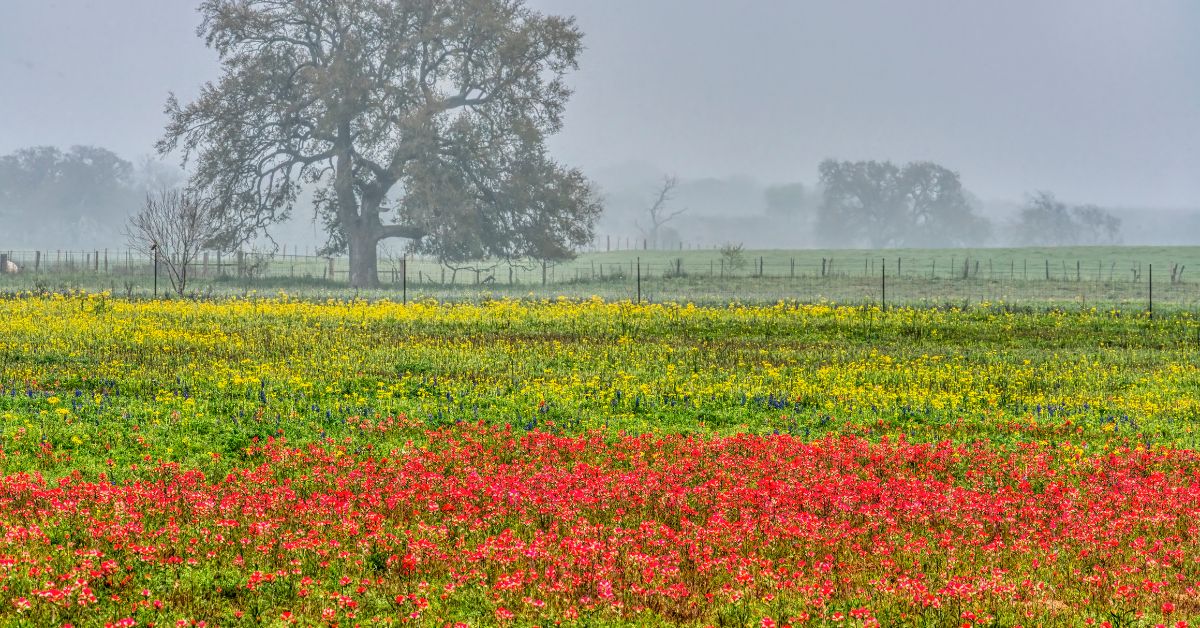
Overcoming Challenges in Wildflower Landscaping
Let’s tackle the elements and ensure our wildflower landscapes thrive.
Dealing with Harsh Weather Conditions
In Texas, we face a range of weather extremes, from scorching summers to icy winters. The key to success with our wildflowers is choosing the suitable species. Native wildflowers like bluebonnets and Indian paintbrush are pre-tuned to weather the storm. They’ve evolved to endure the heat and can often bounce back from frost with vigor. Remember to water them during drought conditions and provide shade when the sun beats down the hardest.
Soil Erosion and Landscaping Solutions
Our wildflowers can’t take root if the soil keeps washing away. We’ve got some tricks up our sleeves to prevent this. For starters, grouping our plants closely creates a living mat that guards against erosion. We can also lay down a layer of mulch to shield the soil. If the slope is steep, consider terracing or utilizing erosion control blankets to provide extra stability until the plants can establish themselves. With a bit of preparation, we’ll have those wildflowers blossoming quickly!
Case Studies of Successful Texan Wildflower Landscapes
We’ve seen several inspiring examples of Texan wildflower use in landscaping that enhances the environment’s beauty and supports local ecosystems.
The Lady Bird Johnson Wildflower Center showcases a spectacular array of native wildflowers and serves as a model for sustainable landscaping. Their gardens display the resilience and variety of Texan flora, with bluebonnets, Indian paintbrushes, and evening primroses.
Highlight: Sustainable Practices
- Use of rainwater collection and solar energy
- Native plantings that reduce water use and maintenance
Downtown Houston Green Spaces utilize wildflowers to transform urban areas into inviting natural retreats. This effort beautifies the city and provides a habitat for pollinators within the urban core.
Highlight: Urban Renewal
- Creation of pollinator-friendly zones
- Integration with the city’s stormwater management systems
The Meadows Center for Water and the Environment has implemented a landscape design that blends education with ecology. By incorporating wildflowers native to the Edwards Plateau region, they’ve created a living classroom.
Highlight: Educational Landscape
- Interactive displays around water conservation
- Wildflower paths that encourage ecological learning
Each of these cases demonstrates the incredible potential of Texan wildflowers in landscaping. Our native blooms are more than just eye candy; they’re a functional choice that reinforces our environmental commitment. We’re thrilled to see these wildflower landscapes thrive, proving that beauty and sustainability can go hand in hand.
Share the post "Traditional Texan Wildflowers: Be Part of The Colorful Urban Garden Revolution!"
Christian Linden is a seasoned writer and contributor at Texas View, specializing in topics that resonate with the Texan community. With over a decade of experience in journalism, Christian brings a wealth of knowledge in local politics, culture, and lifestyle. He holds a Bachelor's degree in Communications from the University of Texas. When he's not writing, Christian enjoys spending weekends traveling across Texas with his family, exploring everything from bustling cities to serene landscapes.











